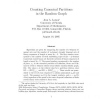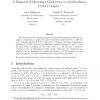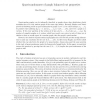3471 search results - page 93 / 695 » Obstacle Numbers of Graphs |
COMBINATORICA
2008
13 years 7 months ago
2008
Algorithms are given for computing the number of n-element diagonal sets and the number of n-element strongly diagonal sets of binary sequences of length at most 2n - 2. The first...
DM
2002
13 years 9 months ago
2002
Let ir(G) and (G) be the irredundance number and the domination number of a graph G, respectively. A graph G is called irredundance perfect if ir(H) = (H), for every induced subgr...
DM
2006
13 years 9 months ago
2006
Let n(G) denote the number of vertices of a graph G and let (G) be the independence number of G, the maximum number of pairwise nonadjacent vertices of G. The Hall ratio of a grap...
ICDE
2008
IEEE
14 years 10 months ago
2008
IEEE
Due to rapid growth of the Internet technology and new scientific/technological advances, the number of applications that model data as graphs increases, because graphs have high e...
CORR
2010
Springer
13 years 9 months ago
2010
Springer
Quasi-random graphs can be informally described as graphs whose edge distribution closely resembles that of a truly random graph of the same edge density. Recently, Shapira and Yu...



